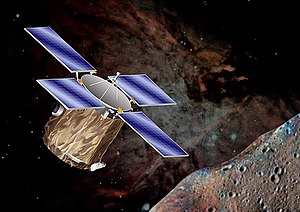NEAR Shoemaker

Artist's impression of NEAR in orbit around Eros.
|
|||||
| Mission type | Orbiter (433 Eros) | ||||
|---|---|---|---|---|---|
| Operator | NASA · APL | ||||
| COSPAR ID | 1996-008A | ||||
| Website | near |
||||
| Mission duration | 5 years, 11 days | ||||
| Spacecraft properties | |||||
| Launch mass | ~800 kilograms (1,800 lb) | ||||
| Dry mass | 487 kilograms (1,074 lb) | ||||
| Power | 1,800 W | ||||
| Start of mission | |||||
| Launch date | February 17, 1996 20:43:27 UTC (20 years, 11 months and 16 days ago) |
||||
| Rocket | Delta II 7925-8 | ||||
| Launch site | Cape Canaveral LC-17 | ||||
| End of mission | |||||
| Last contact | February 28, 2001 ~00:00 UTC (15 years, 11 months and 5 days ago) |
||||
| Landing date | February 12, 2001 20:01 UTC (15 years, 11 months and 21 days ago) |
||||
| Landing site | South of Himeros crater, 433 Eros | ||||
| Flyby of 253 Mathilde | |||||
| Closest approach | June 27, 1997 12:56 UTC (19 years, 7 months and 6 days ago) |
||||
| Distance | 1,212 kilometres (753 mi) | ||||
| 433 Eros orbiter | |||||
| Orbital insertion | February 14, 2000 15:33 UTC (16 years, 11 months and 19 days ago) |
||||
| Orbits | 230 orbits | ||||
|
|||||
The Near Earth Asteroid Rendezvous – Shoemaker (NEAR Shoemaker), renamed after its 1996 launch in honor of planetary scientist Eugene Shoemaker, was a robotic space probe designed by the Johns Hopkins University Applied Physics Laboratory for NASA to study the near-Earth asteroid Eros from close orbit over a period of a year. The mission succeeded in closing in with the asteroid and orbited it several times, finally terminating by touching down on the asteroid on 12 February 2001.
The primary scientific objective of NEAR was to return data on the bulk properties, composition, mineralogy, morphology, internal mass distribution and magnetic field of Eros. Secondary objectives include studies of regolith properties, interactions with the solar wind, possible current activity as indicated by dust or gas, and the asteroid spin state. This data will be used to help understand the characteristics of asteroids in general, their relationship to meteoroids and comets, and the conditions in the early Solar System. To accomplish these goals, the spacecraft was equipped with an X-ray/gamma-ray spectrometer, a near-infrared imaging spectrograph, a multi-spectral camera fitted with a CCD imaging detector, a laser rangefinder, and a magnetometer. A radio science experiment was also performed using the NEAR tracking system to estimate the gravity field of the asteroid. The total mass of the instruments was 56 kg, and they required 80 W power.
...
Wikipedia
